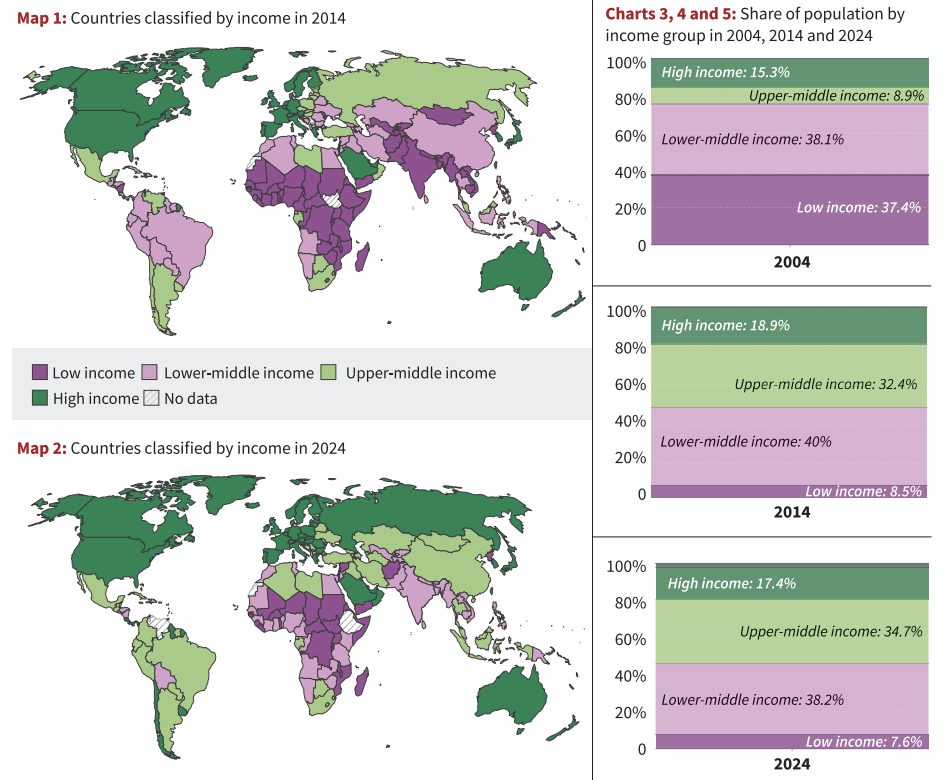Why in the News?
Recently, the World Bank’s 2024 update to its income classification system revealed major shifts, with a sharp decline in low-income populations and a rise in upper-middle-income countries.
Global Income Classification Trends (2004–2024): Key Shifts in Population Distribution:
|
What is the World Bank’s income classification?
- Four Income Groups: Countries are classified into low, lower-middle, upper-middle, and high-income based on their Gross National Income (GNI) per capita.
- Annual Update: Classifications are updated yearly, adjusting for global inflation and changes in income.
- Absolute Thresholds: Groupings are based on fixed income thresholds, not relative comparisons with other countries.
- Low income: GNI per capita ≤ $1,135
- Lower-middle income: $1,136 – $4,465
- Upper-middle income: $4,466 – $13,845
- High income: ≥ $13,846
How is GNI per capita used in this system?
- It measures the average income per person, including income from abroad.
- GNI figures (reported in local currency) are converted to USD using exchange rates.
- Countries are placed into groups using predetermined income thresholds.
Why do countries shift between income groups?
- Economic Growth or Decline: Strong GDP growth raises GNI per capita, moving countries to higher groups. Eg: India’s GNI per capita rose from $2,250 (2022) to $2,610 (2023), nearing upper-middle-income status.
- Currency Exchange Fluctuations: A weaker local currency reduces GNI in USD terms. Eg: Egypt’s currency depreciation led its GNI per capita to fall from $3,890 (2022) to $3,240 (2023), reclassifying it from upper-middle to lower-middle-income.
- Population Growth Rates: Fast population growth reduces GNI per capita even if total income rises. Eg: Nigeria’s large population growth kept its GNI per capita at $2,110 (2023), maintaining its lower-middle-income status.
What are the challenges for India as a Lower-Middle-Income Country?
- Limited Fiscal Space: India struggles to allocate sufficient funds for healthcare, education, and infrastructure. Eg: Public health spending remains around 2% of GDP, below the global average of 5–6%.
- High Income Inequality: Rapid growth hasn’t translated into equitable wealth distribution. Eg: The top 10% in India hold nearly 77% of total national wealth (Oxfam, 2023).
- Jobless Growth: Economic expansion hasn’t created enough formal sector jobs. Eg: Despite over 6% GDP growth, unemployment among youth remains high at around 45% (CMIE, 2023).
What are the steps taken by the Indian government?
- PM Gati Shakti Mission: Enhances infrastructure development for seamless connectivity and job creation.
- National Education Policy (NEP) 2020: Aims to improve access, equity, and quality in education, especially in rural areas.
- Ayushman Bharat Scheme: Provides free healthcare to over 50 crore people, addressing public health gaps.
- Make in India & PLI Schemes: Promote domestic manufacturing and boost employment across key sectors.
- Digital India & Skill India: Focuses on digital inclusion and vocational training to equip youth with employable skills.
Way forward:
- Accelerate Inclusive Economic Growth: Focus on MSMEs, rural entrepreneurship, and labour-intensive sectors to boost incomes and job creation.
- Invest in Human Capital: Enhance education quality, healthcare access, and nutritional outcomes, especially for the poor.
- Strengthen Social Safety Nets: Expand direct benefit transfers (DBTs) and targeted subsidies to reduce vulnerability and inequality.
- Promote Technological Innovation: Support startups, R&D, and digital infrastructure to drive productivity and global competitiveness.
Mains PYQ:
[UPSC 2013] The World Bank and the IMF, collectively known as the Bretton Woods Institutions, are the two inter-governmental pillars supporting the structure of the world’s economic and financial order. Superficially, the World Bank and the IMF exhibit many common characteristics, yet their role, functions and mandate are distinctly different. Elucidate.
Linkage: This question directly asks about the World Bank’s role, functions, and mandate. A fundamental aspect of the World Bank’s function is its income classification system, which was initially designed to determine eligibility for loans, particularly concessional ones, based on a country’s average income.
Get an IAS/IPS ranker as your 1: 1 personal mentor for UPSC 2024


